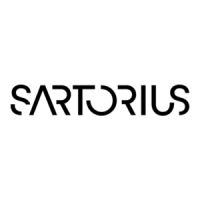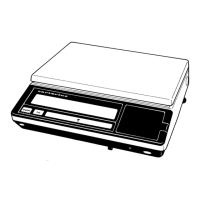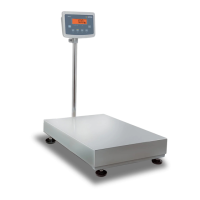Do you have a question about the Sartorius LE series and is the answer not in the manual?
General safety guidelines for operating the balance to prevent damage.
Industrial protection ratings for various balance models and AC adapters.
Guidelines for optimal storage and handling to prevent damage.
Instructions for unpacking and list of included accessories.
Steps for proper installation and conditioning the balance before use.
Information on EU seal requirements for verified balances.
Procedure for attaching the analytical draft shield.
Connecting specific models to their electronics box.
Procedure for installing balances with a 3-sided draft shield.
Steps for connecting the balance to AC power and safety precautions.
Guidance on connecting external devices like printers or PCs.
Information on required warmup time and leveling procedures.
Instructions for securing the balance using an antitheft device.
Identification and explanation of the balance's display and control elements.
Explains the basic weighing function and its key features.
Tips for precise weighing, especially for microbalance models.
Instructions and restrictions for performing weighing below the balance.
Defines calibration and adjustment, and conditions for performing them.
Information on external calibration for accuracy class I balances.
Procedure for internal calibration using the balance's built-in weight.
Configuration options for the calibration and adjustment sequence.
Details on the automatic calibration function based on temperature.
Adapting balance to individual requirements via setup menu.
How to print current balance configuration settings.
Step-by-step guide to changing balance settings using menu codes.
Comprehensive overview of available parameter settings and their options.
Configuring measurement environment parameters and display settings.
Practical example for setting time, date, and display brightness.
Explanation of function keys used within application programs.
Information on using application programs with legal measuring instruments.
Weighing multiple components into a defined total weight.
Setting up net-total formulation and understanding printout data.
Determining part count and optimizing accuracy with reference sample updates.
Using a reference balance for higher precision in counting.
Setting parameters for counting and interpreting the printout.
Obtaining weight readouts in percent relative to a reference weight.
Example demonstrating residual weight calculation in percent.
Weighing unstable samples and calculating the average weight.
Example of determining animal weight with automatic start.
How to switch between two configured weight units.
Generating printouts with weights, values, and IDs.
Understanding printout formats with and without data ID codes.
Parameters included in GLP header/footer and settings for output.
Examples of ISO/GLP compliant printouts for measurements and calibration.
Connecting to computers or peripherals via the serial interface port.
Explanation of data output formats, special codes, and error codes.
Sending commands to the balance via the interface port.
Detailed pin assignment charts for female and male connectors.
Warning about incorrect pin assignments on third-party RS-232 cables.
Information on service contracts and requirements for repair work.
Guidelines for cleaning the balance and its stainless steel parts.
Actions to take if safe operation is no longer warranted.
Guidelines for proper disposal of packaging, equipment, and batteries.
Detailed technical specifications for various balance models.
Specifications for models with EC type-approval, including accuracy class.
Information on optional data printers and remote displays.
Details on external battery packs and carrying cases for balances.
Optional software, density kits, antistatic pans, and calibration weights.
Optional industrial AC adapters and analytical draft shield chambers.
Optional data cables, adapters, and remote control switches.
Directive 90/384/EEC regulating mass determination in legal metrology.
Information on Sartorius' EC verification services and subsequent verifications.
Confirmation of compliance with EU directives for electronic weighing instruments.
Declaration of Type Conformity for non-automatic weighing instruments.
Diagrams showing locations of CE mark, EC verification stickers, and model designations.
Illustrations of model designation plates and descriptive plates.
General safety guidelines for operating the balance to prevent damage.
Industrial protection ratings for various balance models and AC adapters.
Guidelines for optimal storage and handling to prevent damage.
Instructions for unpacking and list of included accessories.
Steps for proper installation and conditioning the balance before use.
Information on EU seal requirements for verified balances.
Procedure for attaching the analytical draft shield.
Connecting specific models to their electronics box.
Procedure for installing balances with a 3-sided draft shield.
Steps for connecting the balance to AC power and safety precautions.
Guidance on connecting external devices like printers or PCs.
Information on required warmup time and leveling procedures.
Instructions for securing the balance using an antitheft device.
Identification and explanation of the balance's display and control elements.
Explains the basic weighing function and its key features.
Tips for precise weighing, especially for microbalance models.
Instructions and restrictions for performing weighing below the balance.
Defines calibration and adjustment, and conditions for performing them.
Information on external calibration for accuracy class I balances.
Procedure for internal calibration using the balance's built-in weight.
Configuration options for the calibration and adjustment sequence.
Details on the automatic calibration function based on temperature.
Adapting balance to individual requirements via setup menu.
How to print current balance configuration settings.
Step-by-step guide to changing balance settings using menu codes.
Comprehensive overview of available parameter settings and their options.
Configuring measurement environment parameters and display settings.
Practical example for setting time, date, and display brightness.
Explanation of function keys used within application programs.
Information on using application programs with legal measuring instruments.
Weighing multiple components into a defined total weight.
Setting up net-total formulation and understanding printout data.
Determining part count and optimizing accuracy with reference sample updates.
Using a reference balance for higher precision in counting.
Setting parameters for counting and interpreting the printout.
Obtaining weight readouts in percent relative to a reference weight.
Example demonstrating residual weight calculation in percent.
Weighing unstable samples and calculating the average weight.
Example of determining animal weight with automatic start.
How to switch between two configured weight units.
Generating printouts with weights, values, and IDs.
Understanding printout formats with and without data ID codes.
Parameters included in GLP header/footer and settings for output.
Examples of ISO/GLP compliant printouts for measurements and calibration.
Connecting to computers or peripherals via the serial interface port.
Explanation of data output formats, special codes, and error codes.
Sending commands to the balance via the interface port.
Detailed pin assignment charts for female and male connectors.
Warning about incorrect pin assignments on third-party RS-232 cables.
Information on service contracts and requirements for repair work.
Guidelines for cleaning the balance and its stainless steel parts.
Actions to take if safe operation is no longer warranted.
Guidelines for proper disposal of packaging, equipment, and batteries.
Detailed technical specifications for various balance models.
Specifications for models with EC type-approval, including accuracy class.
Information on optional data printers and remote displays.
Details on external battery packs and carrying cases for balances.
Optional software, density kits, antistatic pans, and calibration weights.
Optional industrial AC adapters and analytical draft shield chambers.
Optional data cables, adapters, and remote control switches.
Directive 90/384/EEC regulating mass determination in legal metrology.
Information on Sartorius' EC verification services and subsequent verifications.
Confirmation of compliance with EU directives for electronic weighing instruments.
Declaration of Type Conformity for non-automatic weighing instruments.
Diagrams showing locations of CE mark, EC verification stickers, and model designations.
Illustrations of model designation plates and descriptive plates.
| Calibration | External |
|---|---|
| Display | LCD |
| Units | g, kg, ct, lb, oz, ozt |
| Interface | RS-232 |
| Material | Stainless Steel |
| Power Supply | AC Adapter |











